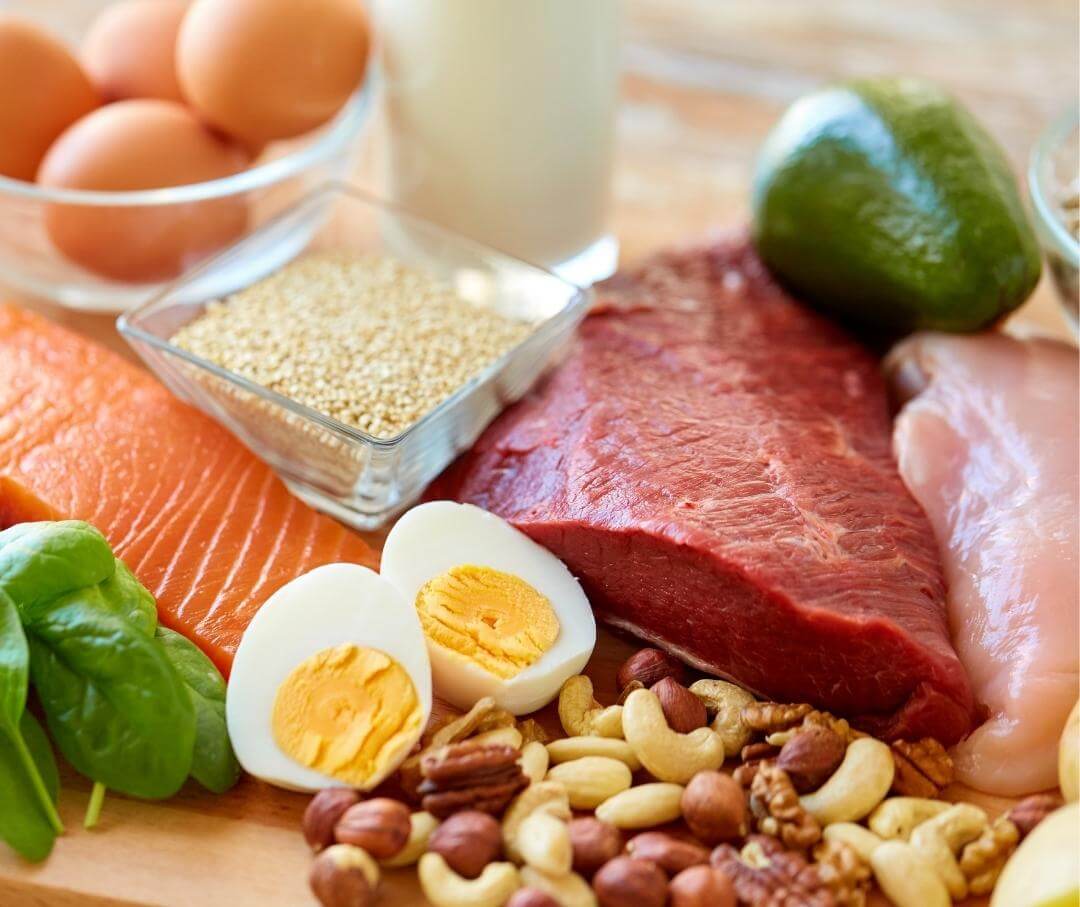Chickpeas are a legume many people consider a superfood and a plant-based source of protein. They contain essential vitamins, nutrients, and proteins in each serving. They’re also versatile beans you can enjoy in a variety of ways. Read this guide to learn about the many health benefits of chickpeas, like improving your digestion and managing weight loss. You’ll quickly know if they would be good for your overall well-being by considering them alongside your health goals.
{{mid-cta}}
Chickpeas Nutritional Value
Chickpeas are a low-glycemic index food with a glycemic index (GI) rating of 10.1 They’re great dietary options for anyone with blood sugar management or weight loss goals. You won’t need to worry about blood sugar spikes after eating them like you would with higher-glycemic proteins.
The many health benefits of these legumes come from the chickpea’s nutritional value. Chickpeas are rich with essential vitamins, minerals, and antioxidants, including
- Folate, which assists in making DNA
- Iron, which carries oxygen in the body
- Magnesium, which regulates blood sugar and blood pressure
- Potassium, which controls blood pressure
- Zinc, which supports the immune system
A 100-gram serving of drained and rinsed canned, cooked chickpeas provides the following nutrients:2
- 137 calories
- 20.3 grams of carbohydrates
- 3.1 grams of fats
- 7.02 grams of protein
- 0 grams of sugar
- 5.92 grams of dietary fiber
- 40 milligrams of calcium
- 1.04 milligrams of iron
- 137 milligrams of potassium
- 202 milligrams of sodium
The chickpea’s nutrition is robust. You won’t find all these nutrients in every food, making this legume a superfood. However, the nutrients also differ between canned and dried chickpeas. Dried chickpeas have the following nutritional value for every 100 grams:3
- 383 calories
- 60.4 grams of carbs
- 6.27 grams of fats
- 21.3 grams of protein
- 0 grams of sugar
- 12.2 grams of fiber
- 111 milligrams of calcium
- 5.09 milligrams of iron
- 1,070 milligrams of potassium
- 9 milligrams of sodium
Many of the nutritional values are higher in dried chickpeas because they haven’t taken on any water. When they do, the nutrients become less condensed. Always cook dried chickpeas before eating to avoid consuming condensed nutrients that could upset your stomach.
<p class="pro-tip"><strong>Also Read: </strong><a href=wheatgrass-benefits>8 Surprising Health Benefits of Wheatgrass You’ll Love</a>.</p>
Chickpeas: Benefits and Risks

There are numerous benefits of chickpeas in your daily diet. These are the primary ways your health might improve by enjoying them regularly.
Benefits
Chickpeas are good for you because they have numerous minerals and nutrients that support a person’s overall well-being. These are the specific benefits people discover when they eat recipes with legumes.
1. Is Nutrient-Dense Food
The nutrition in chickpeas makes them a superfood. They contain essential vitamins and minerals, plus nutrients the body needs to thrive. You’ll get everything all in one serving, creating a healthy foundation for your future cooking adventures. You could add chickpeas to a veggie wrap for a quick meal or snack on them during the day after mixing them with spices.4
These legumes are one of the high-protein vegetables that people love because they’re so versatile. Swapping just one of your typical processed foods with a single serving of chickpeas will elevate your diet with natural nutrients.
2. Improves Appetite Management
Fiber regulates the appetite by digesting more slowly than other nutrients.5 As your body breaks it down, the chickpeas’ protein will keep you satisfied. It’s an excellent way to avoid extra snacks and regulate the hormonal production necessary for weight loss.
These are also some of the many benefits of chickpeas for diabetes. Because your blood sugar levels remain relatively stable, your body can burn off extra fat and more easily get to a healthier body weight for your long-term well-being.
3. Can Help Iron Deficiency
Being a high-protein vegetable makes chickpeas rockstars, but they also assist people with iron deficiencies. The natural iron in the legumes alleviates iron deficiency related to prolonged periods without food6 and can assist with health conditions causing low iron as well.
4. Is An Affordable and Versatile Ingredient for Dieting
If you’re less hungry between meals because your body is managing the protein and fiber from chickpeas, you’ll deal with fewer urges to eat out of boredom or habit. It’s easier to establish a healthier way of eating or sticking with a new diet.
Chickpeas are also affordable. They have a wholesale value of $70.67 per kilogram,7 but that translates to just a few dollars at the grocery store. Dried chickpeas are more budget-friendly than canned chickpeas because they don’t need to cook. However, both are easier on your grocery budget than protein sources like ground beef.
5. Helps Manage Blood Sugar Levels
The chickpea fiber content slows glucose absorption, which is one of the ways the legume helps people with diabetes. You may not need to rely on blood-sugar-balancing medications as much if your diet naturally keeps your levels low. Chickpeas are a great way to make that progress alongside the advice of expert nutritionists.
Chickpeas also protect against developing diabetes, so you can enjoy them as a healthy snack and keep yourself healthier long term. They’re beneficial either way, making the legume appealing to a broader range of people.
6. Lowers Cholesterol and Cancer Risks
Adding more chickpeas to your diet benefits your heart. People often mention them and cholesterol together because the legume keeps arteries clear, which can reduce the chance of heart attacks and heart disease. Research shows chickpeas contain essential fatty acids, which regulate cholesterol levels by promoting cellular function.8
Anyone hoping to reduce their risk of developing cancer could consider eating more chickpeas to accomplish that goal. They contain protein biopeptides that protect the colon and other organs against cancerous cells.9
Risks
Even though chickpeas have numerous benefits, there are also some risks to consider. Evaluate these potential adverse effects before eating chickpeas regularly.
1. Gas and Bloating
The standard chickpea fiber content per serving of canned chickpeas is 5.92 grams.2 The U.S. Food and Drug Administration recommends 28 grams of fiber in an adult’s daily meals.10
If you make a big batch of soup or another chickpea-centered recipe, you’ll likely use a can or two of beans, so you might accidentally eat more than the nearly 6-gram serving size. Overeating fiber causes cramping, bloating, and gas.11
People with sensitive stomachs might also have more gas and bloating if the 5.92-gram serving is too much for their digestive system. You may have more luck avoiding this unfortunate risk by gradually adding chickpeas to your diet so your body has time to adjust to the soluble fiber content.
2. Canned Chickpeas Can Contain BPA
The latest report from the Can Manufacturers Institute shows 95% of canned food doesn’t contain bisphenol A (BPA).12 BPA is a chemical that disrupts the endocrine system, resulting in negative effects on the immune system, reproductive organs, and neuroendocrine processes.13
Even though 95% of cans don’t use BPA in their packaging, that means 5% of food products do. It’s important to check your chickpea cans for a label indicating BPA-free packaging. You’ll safely enjoy the benefits of chickpeas for diabetes, weight loss, and more without worrying about the chemicals in your cans.
3. Saponins Can Cause Diarrhea and Upset Stomach
Saponins are bioactive metabolites that stabilize foods and emulsify food products.14 Although they’re helpful for food processing, eating too many can upset your stomach and cause diarrhea. They irritate the gut lining by attaching to intestinal cells and limiting how many nutrients they can absorb.15 The body gets rid of the extra nutrients and saponins through diarrhea or vomiting.
This side effect of the chickpea’s nutritional value shouldn’t prevent you from trying them. If you stick with the recommended serving size and introduce chickpeas to your stomach in small portions, your body will adjust to the new nutrients in your system.
Easy Ways to Include Chickpeas in Your Diet

When you’re ready to add chickpeas to your diet, there are numerous ways to try them. You could get a package of hummus or make some yourself with a homemade recipe. It’s a healthy dip for chips and veggies, plus a nutritious ingredient in wraps.
Chickpeas are also popular in soups. Warm them in a broth with other vegetables and grains for a well-rounded meal. Chickpea soups could become your new favorite dietary tool to eliminate gluten, improve your irritable bowel syndrome, or make you feel full longer after meals.
Wraps are another way to add more of this legume to your diet. Burrito recipes from India and Mexico often feature some type of bean. Use chickpeas as a plant-based protein to eat an extra-filling healthy wrap.
Don’t forget about the possibility of a delicious roasted chickpea snack. Drain and rinse a can of chickpeas before tossing them in spices like sea salt, paprika, and curry powder. They’ll become a crispy, delicious snack after roasting on a baking sheet in your oven. You could enjoy the benefits of chickpeas on the go or during a sit-down meal, depending on your dietary routine.
Are Chickpeas Good for You?
Chickpeas are good for you because they contain nutrients, vitamins, and minerals that support your overall health. You could add them to meals or snacks to incorporate them into your health plan. They support goals like weight loss, blood sugar management, and cholesterol maintenance when consumed regularly.
As with many other foods, it’s always best to stick with the recommended portion sizes to avoid negative health effects. If you eat too many chickpeas at once, you could experience gas, bloating, or diarrhea.
Learn More About How to Improve Blood Sugar Health With Signos’ Expert Advice
The benefits of chickpeas far outweigh their potential for adverse health effects. If you eat standard portions and introduce them to your diet gradually, you could soon make daily chickpea meals and snacks. By exploring your dietary options, you’ll feel healthier, reach your goals more easily, and gain a more well-rounded diet.
If you’d like to learn more about how to improve your health, manage type 2 diabetes, or control your weight loss, talk with Signos’ experts today. They’ll help you do it effectively with proven measures that teach people how to reach their health goals.
You can also read more about glucose and health management at Signos’ blog, where you’ll find free posts providing in-depth information about foods and health trends. When you’re ready, Signos’ quick quiz can reveal if the program’s right for you. You’re only one step away from changing your health for the better, no matter what your next step looks like.
<p class="pro-tip"><strong>Learn More: </strong><a href=benefits-of-microgreens>The Benefits of Microgreens and Their Uses: A Full Guide</a>.</p>
- Item 1
- Item 2
- item 3
Topics discussed in this article:
References
- Admin. (2021, February 8). Chickpeas: Glycemic Index, Glycemic Load and Nutrition Facts. Glycemic Index Guide. https://glycemic-index.net/chickpeas/
- Admin. (2023, October 26). Chickpeas (Garbanzo Beans, Bengal Gram), Canned, Sodium Added, Drained and Rinsed. FoodData Central. https://fdc.nal.usda.gov/fdc-app.html#/food-details/2644288/nutrients
- Admin. (2023, October 26). Chickpeas, (Garbanzo Beans, Bengal Gram), Dry. FoodData Central. https://fdc.nal.usda.gov/fdc-app.html#/food-details/2644282/nutrients
- Amin. (2020, May 15). Quick Healthy Meal Ideas and Recipes. Apple Spice. https://www.applespice.com/healthy-meal-ideas/
- Qin, W., Ying, W., Hamaker, B., & Zhang, G. (2021). Slow Digestion‐Oriented Dietary Strategy to Sustain the Secretion of Glp‐1 for Improved Glucose Homeostasis. Comprehensive Reviews in Food Science and Food Safety, 20(5), 5173–5196. https://doi.org/10.1111/1541-4337.12808
- Jahan, T., Kalve, S., Belak, Z., Eskiw, C., & Tar’an, B. (2023, March 17). Iron Accumulation and Partitioning in Hydroponically Grown Wild and Cultivated Chickpea (Cicer Arietinum L). Frontiers; Frontiers Plant Breeding. https://www.frontiersin.org/articles/10.3389/fpls.2023.1092493/full
- Admin. (2023, December). Chickpea Spot Price. Ycharts. https://ycharts.com/indicators/chickpea_spot_price
- Salaria, S., Boatwright, J. L., Johnson, N., Madurapperumage, A., Joshi, P., Thavarajah, P., Vandemark, G., & Thavarajah, D. (2023, August 27). Fatty Acid Composition and Genome-Wide Associations of a Chickpea (Cicer Arietinum L.) diversity panel for biofortification efforts. Scientific Reports, 13(1), 14002. https://doi.org/10.1038/s41598-023-41274-3
- Sehar, S., Rabail, R., Munir, S., Shakeel, K., Khalil, A. A., Tufail, T., Abid, M., Mukhtar, K., Nabi, B. G., Goksen, G., & Aadil, R. M. (2023, December). An Insight Into Anticancer Perspectives of Chickpea Bioactive Compounds. Food Chemistry Advances, 3, 100453. https://doi.org/10.1016/j.focha.2023.100453
- Center for Food Safety and Applied Nutrition. (2023, September 27). Daily Value on the Nutrition and Supplement Facts Labels. FDA. https://www.fda.gov/food/nutrition-facts-label/daily-value-nutrition-and-supplement-facts-labels
- Ioniță-Mîndrican, C.-B., Ziani, K., Mititelu, M., Oprea, E., Neacșu, S. M., Moroșan, E., Dumitrescu, D.-E., Roșca, A. C., Drăgănescu, D., & Negrei, C. (2022, June 26). Therapeutic Benefits and Dietary Restrictions of Fiber Intake: A State of the Art Review. Nutrients, 14(13), 2641. https://doi.org/10.3390/nu14132641
- Admin. (2023) CMI Washington State Canned Food Market Basket Survey. Can Manufacturers Institute. https://www.cancentral.com/wp-content/uploads/2023/01/CMI-Washington-State-Canned-Food-Market-Basket-Report-Raw-Data.pdf
- Manzoor, M. F., Tariq, T., Fatima, B., Sahar, A., Tariq, F., Munir, S., Khan, S., Nawaz Ranjha, M. M. A., Sameen, A., Zeng, X.-A., & Ibrahim, S. A. (2022, November 3). An Insight Into Bisphenol A, Food Exposure and Its Adverse Effects on Health: A Review. Frontiers in Nutrition, 9. https://doi.org/10.3389/fnut.2022.1047827
- Yakindra Prasad Timilsena, Arissara Phosanam, & Stockmann, R. (2023, August 31). Perspectives on Saponins: Food Functionality and Applications. International Journal of Molecular Sciences, 24(17), 13538–13538. https://doi.org/10.3390/ijms241713538
- Duraiswamy, A., Man Sneha A., N., Jebakani K., S., Selvaraj, S., Pramitha J., L., Selvaraj, R., Petchiammal K., I., Kather Sheriff, S., Thinakaran, J., Rathinamoorthy, S., & Kumar P., R. (2023, February 15). Genetic Manipulation of Anti-Nutritional Factors in Major Crops for a Sustainable Diet in Future. Frontiers; Frontiers Plant Nutrition. https://www.frontiersin.org/articles/10.3389/fpls.2022.1070398/full































